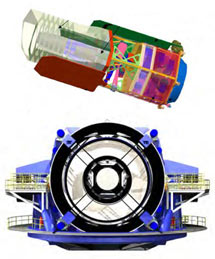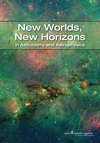Astronomy and Astrophysics Decadal Survey Released
(Originally published by SLAC)
August 13, 2010
The National Academy of Sciences' National Research Council today released New Worlds, New Horizons in Astronomy and Astrophysics, the result of a two-year process, involving hundreds of scientists, that ranks priorities in U.S. astronomy and astrophysics for the next decade. At the top of the list for large-scale missions are the ground-based Large Synoptic Survey Telescope, or LSST, and a space-based observatory called the Wide-field Infrared Survey Telescope, or WFIRST, which is based on proposed designs for the Joint Dark Energy Mission.

LSST is a public–private partnership with 34 members including the Kavli Institute for Particle Astrophysics and Cosmology run by SLAC and Stanford. When constructed, the telescope will scan the skies of the Southern Hemisphere to create 3-D maps of the distribution of mass in the universe. KIPAC is leading the design and construction of the telescope's six-foot-tall, three-billion pixel camera—the biggest digital camera ever built. Combined with the LSST's special three-mirror design, which offers an exceptionally wide field of view, this camera will enable researchers to study the fundamental properties of dark energy and dark matter and take snapshots of objects that quickly change or move against the backdrop of the sky, including exploding stars and near-Earth asteroids.
"The Large Synoptic Survey Telescope would employ the most ambitious optical sky survey approach yet and would revolutionize investigations of transient phenomena," the report states. "It would address the pressing and fundamental question of why the expansion rate of the universe is accelerating, and would tackle a broad range of priority science questions ranging from understanding the structure of our galaxy to elucidating the physics of stars… The top rank of LSST is a result of its capacity to address so many of the identified science goals and its advanced state of technical readiness."
The JDEM mission that is the basis for the top-ranked space mission, WFIRST, is being developed and funded by the US Department of Energy and NASA. SLAC is one of several national laboratories involved in its design. WFIRST would use a 1.5-meter telescope stationed 1.5 million kilometers from Earth, to image the sky at near-infrared wavelengths and perform low-resolution infrared spectroscopy. Researchers hope these observations will answer fundamental questions about the nature of dark energy—including its effect on the evolution of the universe—and about the prevalence and formation of Earth-like planets in other solar systems. The telescope will also survey our galaxy and others to learn about their formation and structure.
"WFIRST addresses fundamental and pressing scientific questions and contributes to a broad range of astrophysics," the report states. "It complements the proposed ground-based program in two key science areas: dark energy science and the study of exoplanets. It is an integral part of coordinated and synergistic programs in fields in which the United States has a leading role."

The report, also known as Astro2010, is the sixth in a series of surveys of astronomy and astrophysics produced every 10 years by the National Research Council, which is the principal operating arm of the National Academies of science and engineering. These private, non-profit societies of distinguished experts were established to advise the federal government; and while their recommendations are not binding, they are considered highly influential. This is the first time the survey has taken into account the technical readiness, schedule and cost of proposed projects.
In addition to LSST and WFIRST, the report recommends several other high-priority missions based on their ability to advance science in key areas. The New Worlds Technology Development Program, which lays the scientific groundwork for a future mission to study nearby Earth-like planets, and the Cerro Chajnantor Atacama Telescope, which would provide short-wavelength radio surveys to study dusty material associated with galaxies and stars, are ranked the highest priority for midsize space- and ground- based programs, respectively.
Overall, the committee found that "to optimize the science return for the decade 2012-2021 within the anticipated resources, [the United States should] focus on three science objectives"— searching for the first stars, galaxies and black holes; seeking nearby, habitable planets; and understanding scientific principles—"while also considering the discovery potential of a much broader research program."
The committee, which was chaired by KIPAC Director Roger Blandford, spent two years assessing the field of space- and ground-based astronomy and astrophysics before arriving at its conclusions. It drew on 324 white papers on science opportunities submitted to the committee, briefings from federal agencies, and the deliberations of nine panels composed of 123 members of the astronomy and astrophysics communities. Some panels identified the scientific drivers of the field and the most promising opportunities for progress in research in the next decade. Other panels then conducted an in-depth study of the technical and programmatic issues and developed a ranked program of research activities. The committee also received input from 71 "Infrastructure Study Group" astronomy and astrophysics consultants and 17 community town hall meetings. In addition, the committee developed independent appraisals of the technical readiness, schedule and cost risks of each project with the help of an outside contractor before making its final recommendations.